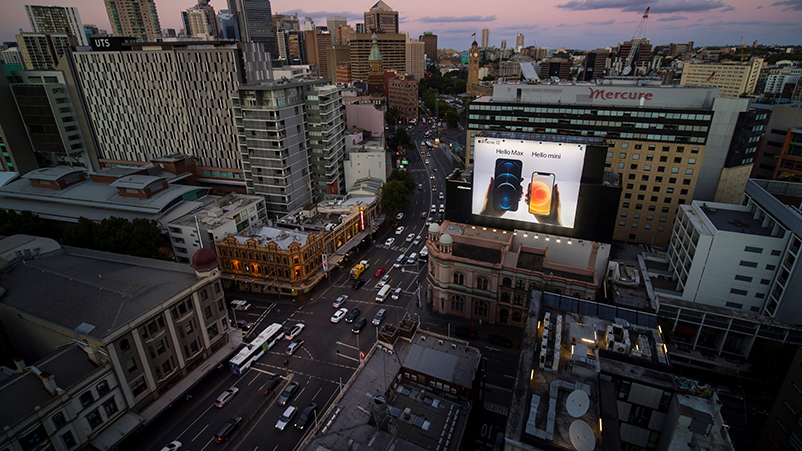If Digital Out-Of-Home isn't part of your strategy in 2022, then you really should take a fresh look at the channel

Data-fuelled digital advertising is evolving into something quite scalable and potent, and the Out-of-Home industry is in a stronger position than ever.
Right now, outdoors is the safest space to be – both for people and arguably for brands aiming to get ahead of incoming privacy changes that will upend almost all other digital channels. It’s time for advertisers to work out cookie-less strategies now, and get ahead of the competition, says JCDecaux CMO, Essie Wake.
It’s likely this won’t be the first time this week you hear times are changing rapidly, and (if you believe popular opinion), we’re all going to hell in a handbasket. But from where I’m sitting, there is still good news to be had. Data-fuelled digital advertising is evolving into something quite scalable and potent, and the Out-of-Home industry is in a stronger position than ever. As we all know, the great outdoors is the safest place for anyone to be right now.
In a world where we’ve spent the past two years looking down at screens, audiences are very keen to start looking up and out at the world again. So, what’s the opportunity for advertisers?
Several recent studies show how Digital Out-of-Home can deliver positive uplift as part of an omnichannel campaign: it can boost digital conversion such as website traffic, social media engagement and search, all while still delivering unrivalled top of the funnel metrics, like brand fame and trust.
Simply put, when combined with other channels, Digital Out-of-Home can increase the effectiveness of your ‘private media’ channels. It has a unique and powerful priming effect that helps make audiences more receptive when they see an already familiar message on their device – and that’s surely compelling for advertisers in the cookieless future that is almost upon us.
It is time to put the cookie jar down and rethink the strategy.
Using one-to-one targeting capabilities, cookies have been tracking people’s online behaviour for a long time. But in the very near future that’s all about to come to an end, and with that, much of the modus operandi of using online advertising will shift. The fundamentals of the way media plans are created will really start to change.
As the saying goes, one person’s problem is another’s opportunity. Proposed Australian government privacy policy changes will create headaches for advertisers who are accustomed to micro targeting people at a personal level. But I’m not alone when I say I believe the move away from third-party cookie-based tracking will be a good reset for the ad industry, a necessary leveller of the playing field.
Is your marketing team considering the role of Digital Out-of-Home in this ‘new different’? If not, you might want to reconsider. JCDecaux recently commissioned a study with Lumen to replicate the impact of cookie targeting on attention and recall of digital advertising. This was then compared to a world where there was no cookie targeting, where you prime your digital advertising with another media - in this case Digital Out-of-Home advertising.
The first key finding (surprise surprise) revealed cookies are a useful business tool. They can be effective and it’s a pity this valuable capability won’t be available to marketers in future. The people who were cookie targeted remembered brands they were exposed to much more. They looked at them longer, and intention to purchase was also higher.
The second big discovery was that priming your online campaign with other media, proved to be a great way to boost attention to those ads. In fact, the attention was equivalent and if there is a strong creative link (think distinctive visual code) between the two channels, then the results of cookie targeting can be replicated.
So, while we may no longer have cookies in our future, there are other alternatives that in many ways might bring even richer audience experiences to life.
Digital Out-of-Home is a privacy-compliant channel that has always traded and targeted cohort audiences. The channel is somewhat future-proofed (audiences can’t and don’t switch off) and it’s evolving creatively too. The potential of Digital Out-of-Home to deliver dynamic, contextual campaigns makes it the most effective and exciting advertising channel around right now.
Why do you think the digital behemoths (such as Apple, Alphabet and Amazon) turn to Out-of-Home time and time again? They do so because they know it pays off. The channel is unique. It works not simply because you see the message, but because it’s a public screen. Everyone around you sees the message, and everyone around you knows that everyone else saw the message too. This collective real-world experience reinforces understanding and trust in a brand, its values, and its shared appeal. Perfect social proof for brands with big, awareness-driving objectives.
Marketers around the world are waking up to just what a powerful business tool a brand is. And brand trust is one of the critical issues marketers face right now. Research points to real change around where audiences place their trust. Presence in the real world and being on the public screen helps to build brand trust in a world where customers are being bombarded with messages online, or on social media, where often credibility can come into question.
Ladder the immediacy and targeting sophistication of programmatic across Digital Out-of-Home and advertisers are now able to activate high value audiences and truly stop thinking about media channels in silos. We can now think across the whole consumer journey and across a digital ecosystem, planning for multiple message touchpoints and impressions.
With our deep understanding of consumers and the data and technology landscape, JCDecaux will be leading clients through this change, helping to optimise their activity, introduce new, seamless online-offline targeting approaches and elevate the audience experience.
We’re on an important journey, you should get on board.
